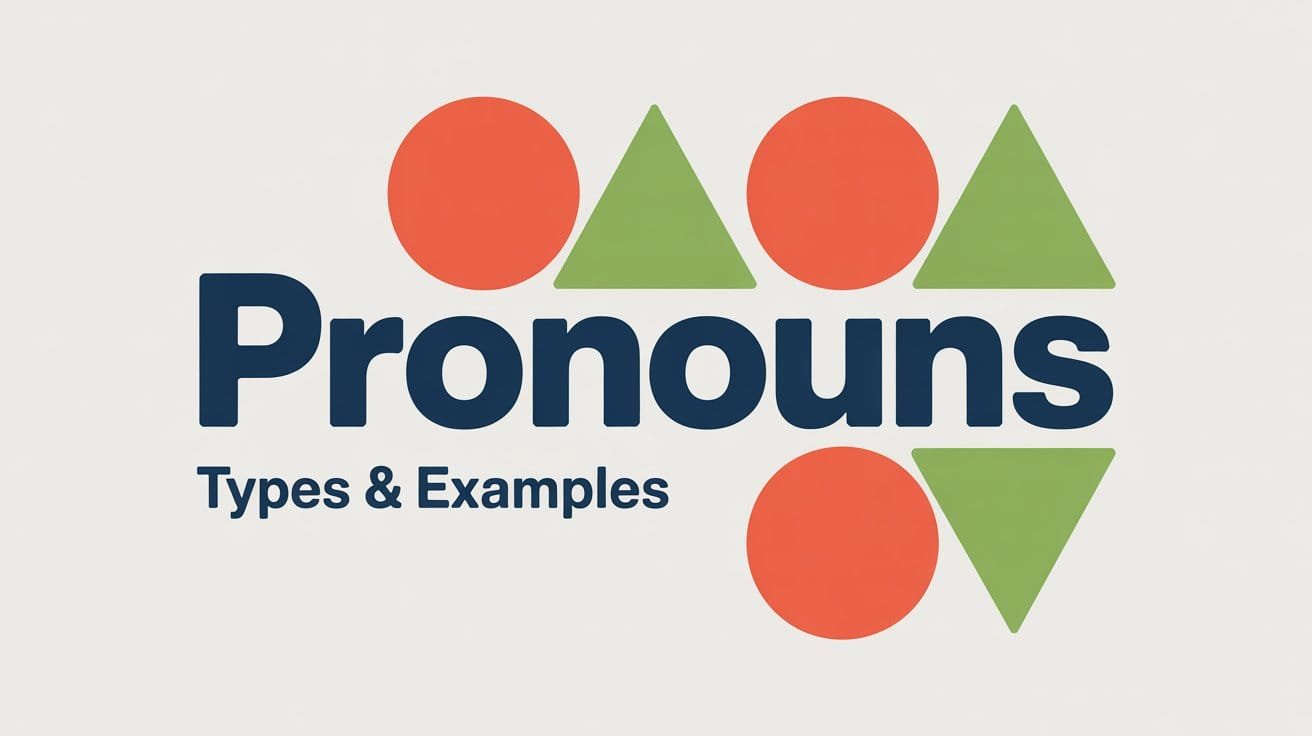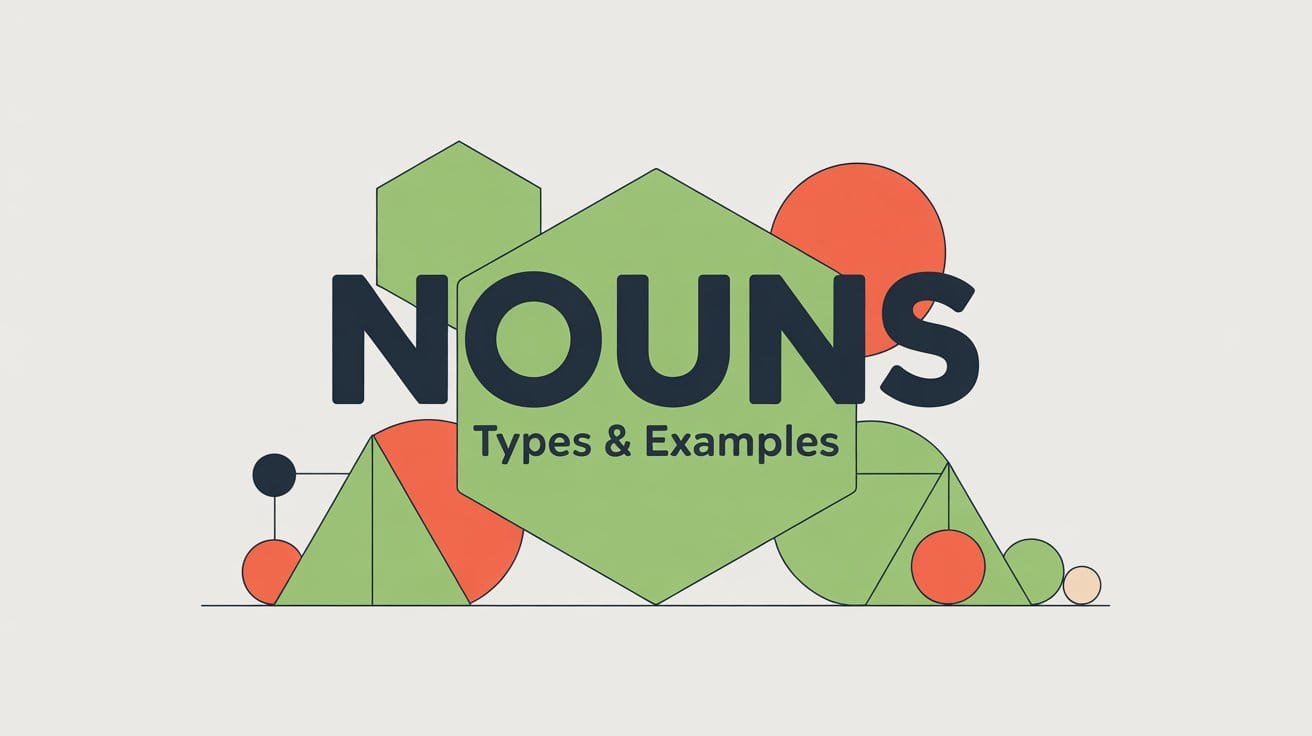Pronouns in English are handy words that help us talk and write more effectively. They replace nouns to avoid repetition. Even if you don’t know them as ‘pronouns,’ you use them in everyday conversations. Words like I, you, he, she, it, who, which, that, ours, mine, and her are all pronouns.
This article will help you understand how to use pronouns correctly, preventing grammar mistakes in speaking and writing. We’ll discuss different types of pronouns and the rules for using them.
What is a Pronoun? Pronouns in English
Pronoun definition: Pronouns in English grammar are one of the eight parts of speech; we use them to replace nouns. In simple terms, a pronoun is a word that replaces or takes the place of a noun in a sentence. Pronoun examples are; I, you, we, they, he, she, it, mine, myself, etc.
Pronouns are essential in English because they make conversations smoother, more engaging, and less complex. Without pronouns, English conversations would be repetitive and monotonous.
To illustrate this, consider the following paragraph:
“Mr. Brown lives in a small town. Mr. Brown is 50 years old. Mr. Brown owns a bookstore. Mr. Brown is a kind and loving person. Everyone likes to spend time with Mr. Brown.“
This sounds repetitive and dull; doesn’t it? However, using pronouns we can make it more meaningful and engaging.
Let’s see,
“Mr. Brown lives in a small town. He is 50 years old. He owns a bookstore. He is a kind and loving person. Everyone likes to spend time with him.“
Now, it seems better, right?
Types Of Pronouns
There are many different types of pronouns, each serves a specific purpose. Below are the types of pronouns you need to know:
- Personal Pronouns
- Subject Pronouns
- Object Pronouns
- Possessive Pronouns
- Reflexive Pronouns
- Relative Pronoun
- Demonstrative Pronouns
- Indefinite Pronouns
- Distributive Pronouns
- Interrogative Pronouns
- Reciprocal Pronoun
Different Types Of Pronouns With Examples
Let’s understand the types of pronouns with their definition and examples.
Personal Pronouns
I, we, you, he, she, it, and they are the pronouns referred to as personal pronouns. You can represent or substitute any noun with these pronouns. All these pronouns are categorized into First person, Second person, and Third person.
When you talk to someone, you talk about something, right? So, you are the “first person”, as you are the person speaking. The person you are talking to is the “second person,” and the thing you are talking about is the “third person.”
For example; I am telling you they are coming.
- I – First person (the person speaking)
- You – Second person (the person spoken to)
- They – Third person (the person spoken of)
Moreover, pronouns can be further categorized. For instance, we have singular and plural pronouns to refer to singular and plural nouns (things, places, and people). Additionally, there are gender-specific pronouns for masculine, feminine, and neuter entities.
To grasp this concept better, take a look at the table below, which provides examples of personal pronouns:
| Number | Gender | Personal Pronoun |
|---|---|---|
| Singular | Male/Female | I |
| Male/Female | You | |
| Male | He | |
| Female | She | |
| Neuter | It | |
| Plural | Male/Female | We |
| Male/Female | You | |
| Male/Female/Neuter | They |
Personal Pronouns Used in Sentences
Personal Pronoun Examples:
- People become what they think. (Here, ‘they’ is the personal pronoun referring to the noun ‘people’)
- My sister came here yesterday. She will stay with me for a week.
- Amy bought a new dress, but it didn’t look good on her.
Subject Pronouns
We know that the structure of a sentence is: Subject + Verb + Object. In a sentence, a subject pronoun is used in place of a subject (noun). That means we use subject pronouns to replace the subject in the sentence.
For instance, Amy bought a new dress. Here, ‘Amy’ is the subject in this sentence. If we say she bought a new dress, we have replaced the subject ‘Amy’ with the pronoun ‘she.’ The pronoun ‘she’ is a subject pronoun because it’s in the place of the subject in the sentence.
Subject pronoun examples are I, you, he, she, it, we, and they.
Subject Pronouns Used in Sentences
Subject Pronoun Examples:
- You do not have to do this.
- We are going to Canada next week.
- She doesn’t like outdoor activities.
Object Pronouns
An object pronoun is used in place of an object (noun) in a sentence. That means we use object pronouns to replace the Object in the sentence. For example, Susan has ten new dresses. She bought them last month. Here, ‘them’ is an object pronoun, it replaces the object ‘dresses’ in the sentence.
Me, you, him, her, it, us, and them are the object pronouns.
Object Pronouns Used in Sentences
Object Pronoun Examples:
- Please give my regards to him.
- My mother wants to talk to you.
- Did you meet her yesterday?
- You don’t need to come with us.
| Gender | Person | Subject Pronoun | Object Pronoun |
|---|---|---|---|
| Male/ Female | First Person Singular | I | me |
| Male/ Female | Second Person Singular | You | you |
| Male | Third Person Singular | He | him |
| Female | She | her | |
| Neuter | It | it | |
| Male/ Female | First Person Plural | We | us |
| Male/ Female | Second Person Plural | You | you |
| Male/ Female/ Neuter | Third Person Plural | They | them |
Possessive Pronouns
Possessive pronouns are used to express a sense of authority or relation. They show who owns something by representing that ownership. Possessive pronoun examples are mine, yours, his, hers, ours, and theirs.
Examples of Possessive Pronouns with Sentences:
- I went shopping with my best friend yesterday.
- His sister got married recently.
- Her husband is not a doctor.
- Susan got a tattoo on her left arm.
- This beautiful house is theirs.
Possessive Pronouns and Adjectives
Some possessive pronouns act as adjectives to modify a noun in a sentence. They do not replace the noun; they only modify it. They are called possessive adjectives. Possessive adjectives are my, his, her, your, its, our, and their.
When you say, “This is my house,” here, “house” is a noun, but the pronoun ‘my’ does not replace the noun. Instead, it modifies the noun ‘house’ to give more information. So, the pronoun ‘my’ is an adjective here.
| Personal Pronoun | Possessive Adjective | Possessive Pronoun |
|---|---|---|
| I | My | Mine |
| We | Our | Ours |
| You | Your | Yours |
| He | His | His |
| She | Her | Hers |
| They | Their | Theirs |
| It | Its | Not used |
Reflexive Pronouns
When the subject and the object of a sentence are the same, we use reflexive pronouns. Reflexive pronouns are words (pronouns) ending in –self or –selves. In English grammar, reflexive pronouns are myself, yourself, himself, herself, oneself, itself, ourselves, yourselves, and themselves.
| Number | Personal Pronoun | Reflexive Pronoun |
|---|---|---|
| Singular | I | Myself |
| You | Yourself | |
| He | Himself | |
| She | Herself | |
| It | Itself | |
| Plural | We | Ourselves |
| You | Yourselves | |
| They | Themselves |
Examples of Reflexive Pronouns with Sentences:
- I do my work myself.
- We do our work ourselves.
- You cook dinner yourself.
- Harry does his homework himself.
- They made it themselves.
- Mona looks at herself in the mirror every morning.
Relative Pronoun
The next type of pronoun is the relative pronoun. It refers to or relates to a noun that comes before it. Besides doing its job as a relative pronoun, it also serves the purpose of a conjunction. You might ask why it works as a conjunction. That’s because it connects two statements.
“This is the dress which I bought yesterday.” In this example, “which” is a relative pronoun, and “dress” is the noun. So, the relative pronoun “which” refers to or relates to the noun “dress.” It establishes a relation with the noun.
In other words, it tells that we are talking about that particular thing (the dress). Now, if you pay close attention to the sentence, you will notice that it was formed by combining two statements.
Statement 1. This is the dress.
Statement 2. I bought it yesterday.
Because “which” combines these two statements, it also acts as a conjunction. So, now you know why relative pronouns also serve the purpose of conjunction.
Examples of Relative Pronoun include which, who, whose, whom, that, what
Examples of Relative Pronouns in Sentences:
- This is the man who stole my wallet last night.
- The girl who was sitting here was my sister.
- The phone which you broke was mine.
- The book which you are reading is not very interesting.
Demonstrative Pronouns
Pronouns used to refer to specific people or objects are called demonstrative pronouns. Demonstrative pronoun examples are this, that, these, and those.
The demonstrative pronouns this and these are used to point to nearby objects or items. We use this for singular and these for multiple items or things.
- These are lovely flowers. I want to get my wife some flowers like these.
- This is a beautiful park with lots of greenery.
On the other hand, both that and those used to point to items far away. We use “that” for single and “those” for multiple items or objects.
- That is Alex, my finance adviser.
- Those chairs are more robust than these.
Indefinite Pronouns
A pronoun that refers to a noun in a general way but not to a particular person or thing is an indefinite pronoun. Indefinite pronoun examples include all, some, more, many, most, any, somebody, nobody, anyone, etc.
You must have heard the famous saying, “All that glitters is not gold.” The word “all” refers to a noun in a general sense. It is not definite and does not specify what it refers to. So “all” is an indefinite pronoun.
Indefinite Pronoun Examples: In a Sentence
- There was someone at the door.
- Despite the poor man’s need, nobody was willing to help him.
- Some of the T-shirts I bought didn’t fit me well, so I had to return them.
- Most of the students have submitted their projects.
- He does not want anyone to help him.
Distributive Pronouns
Distributive pronouns refer to a group members individually, one at a time. They represent each member separately. Distributive pronoun examples are each, either, neither.
Distributive Pronouns Examples – In a Sentence
Each: Refers to every individual (person or thing) within a group.
- Each of them is a student at my school.
- We each donated 50 dollars to the charity.
- Today, each of the books is on sale.
Either: Refers to one or the other of two persons or things.
- I have two books to read; you can borrow either of them.
- I have applied for two jobs and hope to receive a call from either.
Neither: It means neither one nor the other when referring to two persons or things.
- Neither of you can watch TV after 9 pm.
- Neither dress looks good on you.
Interrogative Pronouns
The interrogative pronoun is one of those words used in place of a noun to ask a question in the context of that noun. Interrogative pronoun examples are what, which, when, whose, who, etc.
Interrogative Pronouns Examples
- Who was that girl?
- Which of you came late to today’s meeting?
- Whose report is incomplete?
- What do you do on the weekends?
Reciprocal Pronoun
When there are two or more people or things, and each acts towards the other in the same manner, we use reciprocal pronouns to indicate that. For instance, “Joseph always helps me, and I always help him.” To express this more simply, we can use the reciprocal pronoun and say, “Joseph and I always help each other.“
We have only two reciprocal pronouns: each other and one another. Usually, we use each other when talking about two people or things. And we use one another for more than two people or things.
Reciprocal Pronoun Examples
- These two kids always fight each other.
- Alex and Tom hate each other.
- It appears that they are all cheating on one another.
- In the workplace, employees should respect one another.
Frequently Asked Questions (FAQs) – Pronouns in English
What is the definition of a pronoun?
The definition of a pronoun is “a word that replaces a noun in a sentence is known as a pronoun”. (Replace means takes the place of nouns.)
How many types of pronouns are there in English?
There are several types of pronouns in English, including personal pronouns (I, you, he, she, it, we, they), demonstrative pronouns (this, that, these, those), possessive pronouns (mine, yours, his, hers, its, ours, theirs), relative pronouns (who, whom, whose, which, that), interrogative pronouns (who, whom, whose, which, what), and reflexive pronouns (myself, yourself, himself, herself, itself, ourselves, yourselves, themselves).
What is the difference between subject and object pronouns?
Subject pronouns are used as the subject of a sentence or clause (e.g., “I went to the store”). Object pronouns are used as the object of a verb or preposition (e.g., “She gave it to me”).
When should I use “who” vs. “whom”?
“Who” is used as a subject pronoun (e.g., “Who is coming to the party?”), while “whom” is used as an object pronoun (e.g., “To whom did you give the book?”).
Can you give examples of possessive pronouns?
Certainly! Examples of possessive pronouns include “my,” “your,” “his,” “her,” “its,” “our,” and “their.” For instance, “This is my book.”
What are reflexive pronouns used for?
Reflexive pronouns are used to reflect the action of the verb back onto the subject. For example, “I hurt myself” or “She washed herself.”
Are there gender-neutral pronouns in English?
Yes, there are gender-neutral pronouns such as “they/them” that can be used when referring to a person whose gender is unknown or when referring to non-binary individuals.



